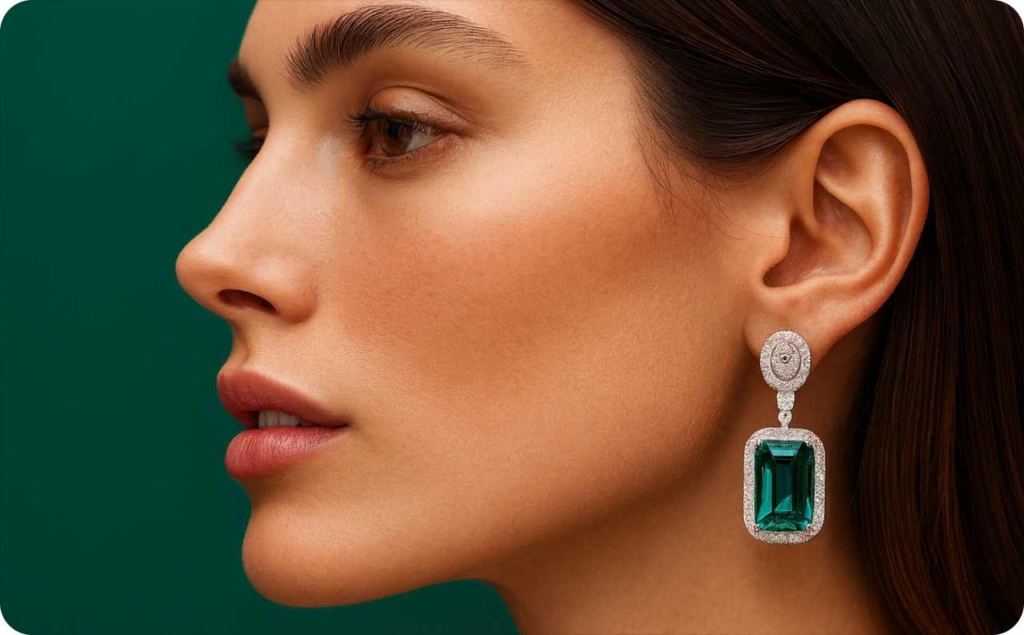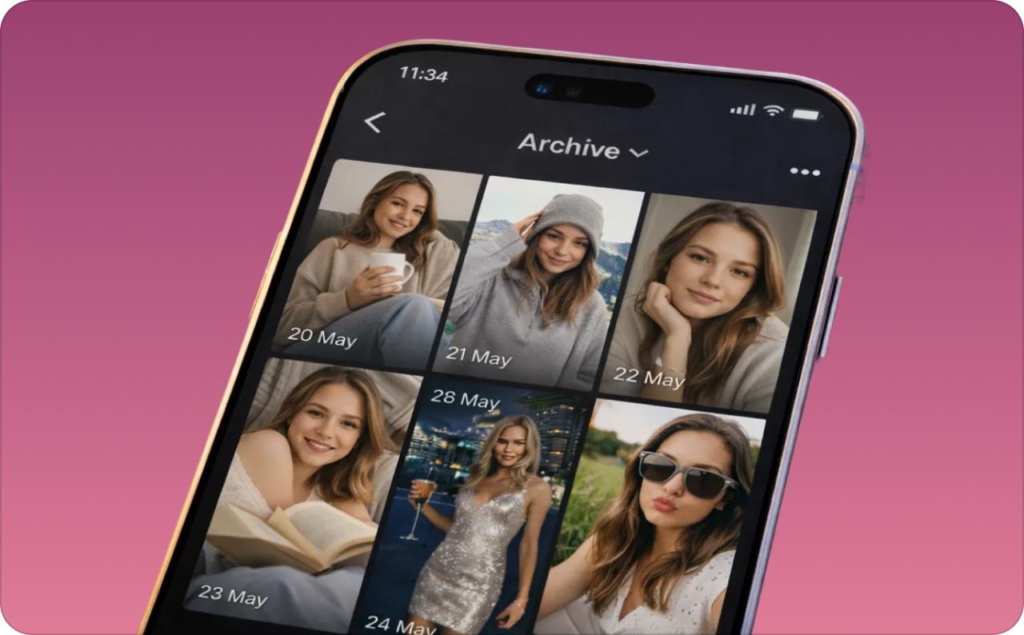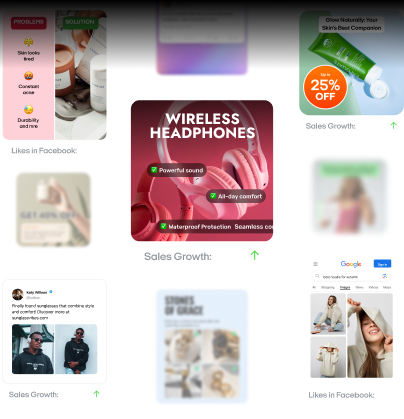Scroll stopping hooks: 5 techniques to engage your audience
Struggling to grab attention in the first few seconds? Discover five proven hook techniques that make viewers stop, watch, and act, insights refined by Zeely AI’s creative ad research.
If you don’t hook your audience in the first two or three seconds, your content might as well not exist. A scroll-stopping hook, whether it’s a bold claim, shocking statistic, or visually striking opener, sparks curiosity and encourages people to stay for the rest of your message.
Think of your opening line as the gateway to everything that follows. Deliver immediate impact, and viewers are far more likely to drop a like, leave a comment, or hit “share” right away.
Research shows attention-grabbing hooks can boost click-through rates by up to 67%, preventing your content from fading into a crowded feed.
This sense of urgency is backed by Statista, which notes that in 2023, 65.9% of surveyed app users will always skip an in-app video ad if given the option, while only 19.7% continue watching when it’s relevant to them.
That statistic underscores just how crucial your first few moments are: if you don’t reel them in fast, you risk being skipped — perhaps forever.
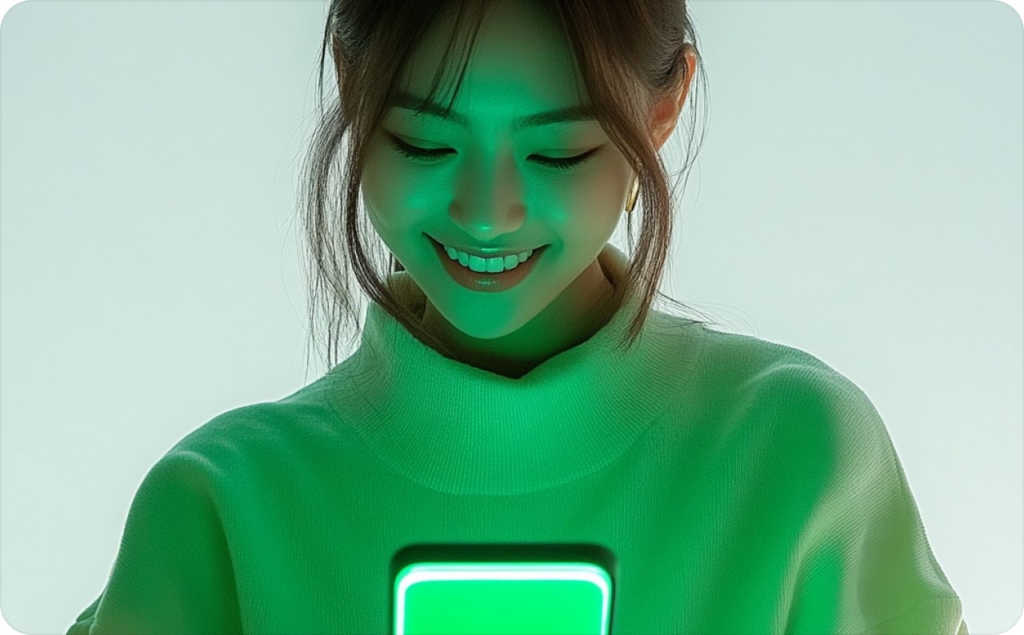
Key outcomes you can expect
- Increased engagement. Convert casual scrollers into active commenters, sharers, and subscribers
- Fresh ideas on repeat. Break free from creative fatigue with a variety of proven hook styles, from viral content hooks to visual teasers
- Better conversions. High engagement frequently translates into higher conversions, be it more followers, sales, or click-throughs
Ready to transform your approach and hook your audience from the very first second? Let’s dive in!
Why effective hooks are essential for social media success
Wondering why scroll-stopping hooks matter so much? It’s simple: they decide whether your post, Story, or video shines through the noise or disappears into an endless feed.
In a hyper-competitive digital marketing space, you only have a few seconds to show viewers that your content deserves their time. If your opener isn’t gripping, your audience will move on before the real message even appears.
On platforms like Instagram and TikTok, quick attention-grabbing tactics can spark an algorithmic lift, sending your content soaring above competing posts. Hooking viewers early also raises your click-through rate, driving even more reach and visibility.
And with Spout Social noting that social media ads now account for 3 in every 10 dollars spent on digital advertising, it’s clear how competitive attention has become. In this environment, hooking your audience fast is the difference between forgettable ads and content that truly stands out.
How do visual hooks impact your engagement?
Visual hooks don’t just look good; they tap into the shrinking attention span in digital content, using bold colors, dramatic motion, and close-up shots to stop that scrolling thumb. Here’s how that translates across different channels:
- Instagram. Stories and Reels often see a 72% bump in engagement when the first frame pops with a dynamic image
- TikTok. Because videos loop, a strong opener holds attention for multiple views, increasing watch time
- YouTube. Thumbnails and titles work together; if viewers aren’t intrigued by your visual, they’ll never click through
Turning your struggles into ROI
If you’ve struggled with low engagement, missed first impressions, or inconsistent performance, a compelling hook can recast your entire strategy. This is the key benefit of a scroll stopping hook: when you nail that opener, people are far more inclined to watch your full video, drop a comment, or click through to your site.
That engagement directly increases your brand visibility, conversion rates, and content ROI. For even bigger gains, A/B test different hook styles created via Zeely AI ad generator to discover what resonates most with your audience. Armed with that insight, you’ll elevate your success and stand out in today’s relentless social media scroll.
Core techniques to craft engaging hooks
If you’re feeling the pressure to captivate your audience from the very first word, without dull intros or clickbait, you’re not alone. The upside is that scroll-stopping hooks aren’t some mysterious art form.
By blending storytelling, emotional triggers, and creative techniques, you can spark immediate curiosity, whether you’re posting on social media or unveiling a new blog series.
According to American Express, one of the most effective ways to secure attention is to address your customers’ pain points. Pinpoint the top issues they’re eager to resolve, then show exactly how your products or services tackle them. In some cases, this insight might even inspire you to refine or expand what you offer, ensuring you more fully meet market needs.
Tying these solutions into your opening lines not only validates your audience’s concerns but also positions your brand as the one with answers — making those first few seconds count even more.
Start with a pivotal narrative moment
Why does starting with a pivotal moment capture attention? It places your reader or viewer at the exact point where everything changes, creating a dramatic introduction that sparks emotional resonance and immediate curiosity.
If you’re thinking, “How do I pick the right high-stakes scenario?” look for an event that reveals conflict or leads to a defining shift, ensuring your audience wants to know what happens next.

Photo source: L’oreal
Identify a high-stakes scenario
Ask yourself: “Does this moment illustrate triumph or near-disaster?” “Will it keep readers on edge?” For instance, “I risked my entire budget on a last-minute marketing campaign — here’s what I learned about audience psychology.” This pivotal moment hook taps into tension and sets the stage for a bigger narrative payoff.
Choose authentic or fictional
You can share a personal anecdote, like “I almost walked away from my startup after one catastrophic product launch”, or craft a believable fictional example if you need a broader metaphor. Either way, an emotional narrative hook resonates most when it aligns with the core message you’ll unfold.
Evoke emotion
Infuse emotional triggers like fear, hope, or joy to deepen impact. For instance: “We’d gone six months without a single sale — until one midnight phone call changed everything.” Such moments intensify narrative tension, ensuring your audience invests in the outcome.
Tie it to your main theme
Connect your story-based hook back to the broader topic, whether it’s content marketing strategies, leadership advice, or personal growth. Show how this defining moment sparked a key lesson or insight. If you’re teaching marketing funnels, explain how your pivotal decision made or broke a campaign.
By weaving a high-stakes scenario, genuine emotion, and immediate conflict into your opener, you create an attention-grabbing storytelling technique that hooks the audience from the first line — fueling deeper engagement and cementing your content as memorable, rather than mere clickbait.
Be weird to stand out
Being “weird” in content creation means breaking conventional patterns with unusual ideas that intrigue your audience right away. If you’ve ever asked, “How can I use weird or unconventional techniques to craft a hook?” or “What does it mean to be weird in content creation?” consider these unconventional hook techniques:
- Dare to be different. Generate odd yet engaging themes, like an unusual opening referencing retro TV commercials, so viewers stop scrolling to find out what’s happening. This distinctive hook can spark curiosity if it taps into nostalgia or humor
- Align with your brand. Experiment with quirky angles, but ensure each idea complements your core brand identity. Even a bold statement should reinforce your overall messaging rather than conflict with it
- Balance benefits vs. risks. Creative and quirky hooks may drive viral engagement and word-of-mouth buzz, yet too much weirdness can confuse newcomers or undercut your credibility. Weigh how each offbeat concept influences your audience’s perception
- Provide real value. Show how your creative twist solves a real problem or delivers fresh insight. For instance: “I turned every meeting agenda into a short song — here’s how it boosted morale and cut idle chatter.” That way, your weird hook examples remain relevant and memorable
By embracing innovation and letting your boldness shine, you’ll craft attention-grabbing hooks that stand out without compromising authenticity — ultimately sparking deeper connections and leaving a lasting impression on your readers or viewers.
Engage with personal wins and failures
Why is sharing personal experiences effective in a hook? Because it humanizes your content by putting real-life stakes front and center. When you share both triumphs and setbacks, you cultivate a trust-building hook that goes beyond polished facts and speaks to genuine emotion.
How can you balance vulnerability with professional storytelling? Aim for candid moments that resonate without oversharing. If you’re talking about marketing strategy, for example, you might say, “I poured my last budget into a risky ad campaign — and learned more about audience psychology than I did in a year of safe bets.” This honesty draws readers in, but it also stays on-topic.
Use a simple framework
- Set the stage. Introduce the situation or dilemma — like burnout or a sudden win
- Highlight the conflict. Pinpoint the moment you realized a change was necessary
- Reveal the outcome. Show the result, whether it’s a valuable insight or a renewed vision
- Tie it to the bigger picture. Emphasize how this story illustrates your core theme or takeaway
Example: “After my first product launch flopped, I surveyed each disappointed customer, then tweaked my approach based on that honest feedback tripling email opt-ins the second time around.”
By weaving personal hook techniques into your content, you turn vulnerability into a relatable narrative that strengthens audience trust and fuels deeper engagement, all while staying true to your main message.
Pose a thought-provoking question
Thought-provoking questions consistently drive more clicks because they tap into the psychology of curiosity, nudging readers to seek answers you’re about to provide. An intriguing prompt works best when it’s tied to your core message, for instance, “What if you could cut your ad spend in half yet double your leads?”
Types of questions that ignite inquiry
- Open-ended. Encourage genuine conversation, not just yes/no
- Relevant. Pinpoint a real pain point or objective your audience faces
- Specific. Paint a clear scenario, like, “Could you triple your sales in 60 days?”
- Non-leading/ steer clear of questions that force predictable answers and stifle intellectual curiosity
Mini-case study: One marketing blog tested two inquiry hooks — “Ready to boost sales?” vs. “What if you could boost sales by 50% in one month?” The second saw a 40% higher CTR and better audience interaction.
After repeating the test with slight wording changes, they refined their insight-driven question to maximize metrics like time-on-page and comments.
When you track these indicators via A/B testing, you’ll discover which question-based hook resonates most — sparking deeper conversation and guiding readers toward the solutions you provide.
The 3 Hook Rule — visual, text, and verbal
You can leverage the 3 Hook Rule by combining visual hooks, text hooks, and verbal hooks for a multi-sensory approach to content creation. When you use this framework, you avoid over-relying on a single tactic and instead cater to multiple audience preferences at once.
Neuromarketing research shows that multi-dimensional strategies can boost recall by up to 70% — a significant jump if you want your content to stand out from one-dimensional hooks.
When you apply a multi-sensory method that includes visual stimuli, persuasive language, and a spoken narrative, you create distinct entry points for each segment of your audience.
Think of it as offering three distinct “entry points” for your message:
- Visual stimuli — catch the eye instantly
- Persuasive language — engage readers who need logical or emotional triggers
- Spoken narrative hook — build an immediate sense of connection or empathy
By weaving these hooks together, you ensure differentiation and consistency — two factors that keep users from scrolling right past your content.
Visual hook: Stimulating the eye
You can hook your audience by showcasing a bold visual from the very first second, using contrasting hues, dynamic overlays, or standout images that capture attention.
According to digital psychology principles, vibrant visuals trigger rapid recognition, prompting viewers to pause rather than scrolling by. Platforms like Instagram Reels, TikTok, or YouTube all benefit from this approach, since a striking layout can boost click-through rates by up to 60%.
Neil Patel even pinpoints color best practices across different networks:
- Facebook responds well to bright shades like yellow, purple, red, and orange
- Instagram thrives on blue, pink, and yellow accents
- Pinterest sees success with red, purple, and pink palettes
Why does this work? Humans process visuals in milliseconds, making it easier for them to pick up your core theme, whether it’s a particular product or a brand promise, before deciding to continue.
By harnessing powerful color schemes and dynamic design, you ensure your visual hook resonates instantly and compels people to stay.
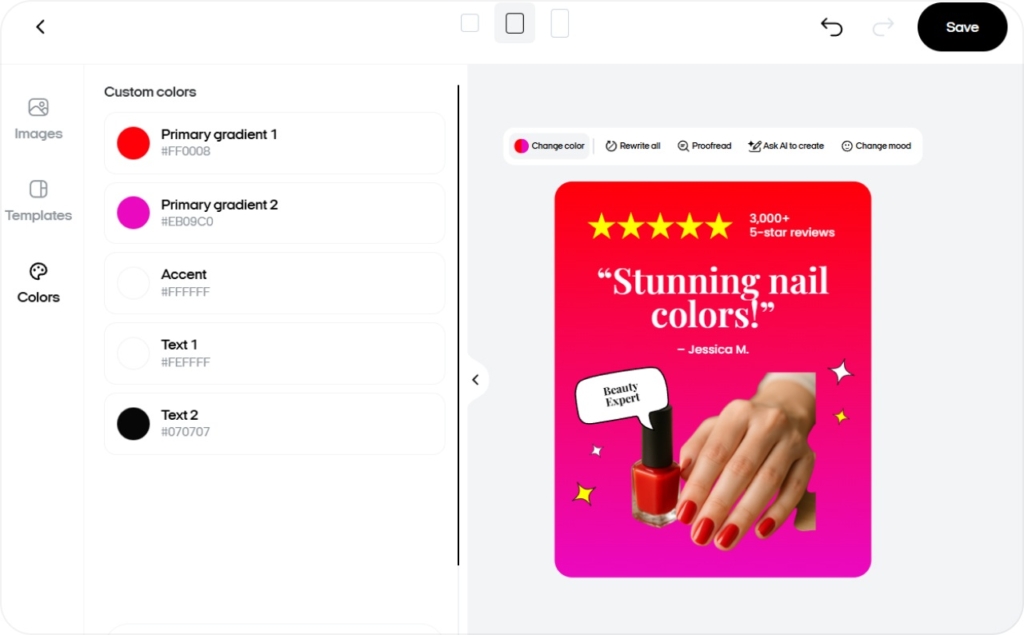
Text hook: Engaging through language
Rely on a text hook whenever you want to spark emotional resonance or intellectual curiosity using persuasive language. By integrating LSI keywords and SEO-friendly hooks, you align with high-traffic queries, boosting discoverability.
Whether you prefer headlines, captions, or short slogans, you can pose thought-provoking questions, highlight compelling statistics, or address specific pain points. A well-constructed text hook also supports your viral content strategy, motivating your audience to share or comment.
A text hook leverages compelling words or phrases to spark curiosity:
- Curiosity-driven statements. “How a $10 Mistake Transformed My Entire Launch”
- Striking statistics. “80% of businesses lose leads due to this one oversight”
- Brand voice variations: A witty approach might suit casual Instagram captions, whereas a data-heavy style works for in-depth blog posts
Why it works: Persuasive language appeals to readers’ sense of logic or emotion — fulfilling different motivations for consumption. If you’re aiming for a viral content strategy, weaving in relevant keywords can also boost discoverability.
Verbal hook: Capturing attention by voice
In a verbal hook, you add a spoken narrative element, like a podcast opener, a YouTube introduction, or the first words in a TikTok voiceover. You can introduce a surprising question, tell a personal anecdote, or make a bold statement to connect instantly with your listeners.
When people hear a human voice, they often feel an emotional bond, which persuades them to stay tuned. This strategy works especially well for live webinars and longer YouTube videos, where your viewers decide within seconds if they’ll keep watching.
- Surprising question. “Ever wonder if your marketing budget is silently draining profits?”
- Brief anecdote. “I almost gave up on my startup until one phone call changed everything”
- Tonality & inflection. Speed, pitch, and energy can signal urgency or relatability
Why it works: Hearing a human voice helps listeners form an emotional tie, bridging digital content and personal interaction. On platforms like YouTube or live webinars, a powerful voice introduction can mean the difference between instant engagement and a quick exit.
Finding your perfect blend
You can create a more sustainable hook framework by blending different techniques like pivotal moments, quirky elements, personal anecdotes, and thought-provoking questions to resonate with multiple audience segments.
When you use this adaptive content strategy, you avoid relying on a single style and, instead, personalize your approach across various brand voices, platforms, and viewer expectations.
Why a blended approach fuels long-term success
By mixing contrasting elements, you activate both emotional and intellectual triggers. Over time, this hybrid hook strategy becomes a flexible blueprint that you can tweak as your community evolves.
For instance, a B2B SaaS brand might discover that a brief anecdote plus a thought-provoking question outperforms a purely statistical opener, while a lifestyle influencer might fuse a pivotal moment with a bold confession to boost watch duration.
Tailoring hooks to different audiences
Audience segmentation plays a crucial role in iterative hook refinement. A younger TikTok audience may love quick transitions and playful banter, whereas a more formal LinkedIn crowd could respond better to personal anecdotes backed by business data. By adapting your mixed hooks to each segment’s preferences, you keep your messaging cohesive yet feel fresh and customized.
Data-driven iteration
Using A/B tests, polls, and engagement metrics, such as time on page, watch duration, and click-through rates, reveals exactly where your personalized hook strategy excels. You might test two versions of a post:
- Version A. Quirky opening anecdote → question about audience pain points → stats-based follow-up
- Version B. Emotional confession → bold statement → comedic twist
If Version B gets higher shares and comments, you can rework Version A with insights from the winning approach. This cyclical retesting ensures you continuously refine your hook blend.
Scaling your custom creative strategy
As you gather more feedback, feed those learnings into a sustainable hook framework that evolves with each platform and audience shift.
Rather than starting from scratch for every campaign, you can fine-tune the blended hooks that reliably fuel long-term loyalty and boost brand recognition. This continuous improvement process turns random experiments into a systematic approach for maximum engagement.
Ultimately, when you commit to an optimized hook mix, one that mirrors your shifting brand voice and audience insights, your content stays vibrant, relevant, and uniquely yours, sustaining a steady flow of captivated viewers and readers.
Testing, ROI, and the fear of clickbait
You often need to balance hook performance with authenticity, making sure you don’t slip into clickbait territory. Data-driven testing helps you refine hooks for stronger ROI, higher engagement, and a trustworthy content strategy that speaks to your target audience.
You can track CTR, watch duration, and conversion data, like cost per acquisition or lifetime customer value, to measure how effectively each hook contributes to return on investment (ROI).
If you notice a jump in CTR that doesn’t lead to product sales or email sign-ups, it’s a sign that curiosity alone isn’t enough. In contrast, even a small rise in CTR that yields a 10% lift in conversions points to a sustainable ROI rooted in genuine user interest rather than mere vanity metrics.
You can run Version A vs. Version B tests across social channels or blog introductions for one to two weeks, gathering data on CTR, conversion rates, and viewer sentiment:
- Version A. Leverages a bold claim paired with a high-impact statistic
- Version B. Opens with a personal anecdote and an intriguing question
Using iterative testing, plus polls, comment sentiment analysis, and engagement metrics like time on page, helps you optimize each hook framework every 30 days or when you launch a new campaign. That way, you keep improving performance over time.
Conclusion
Scroll-stopping hooks aren’t just a flashy tactic. They’re the essential entry point to content that resonates, educates, and converts. By blending visual hooks, textual hooks, and verbal hooks, you cater to a broad range of audience preferences while reinforcing brand identity.
The text emphasizes the importance of addressing pain points, sharing authentic stories, and using offbeat or quirky openings to stand out in a sea of digital noise. Each technique, be it pivotal narratives, bizarre angles, personal wins and failures, or direct questions, must still be rooted in genuine value, not clickbait.
Through A/B testing, iterative data analysis, and thoughtful segmentation, you continually refine which hooks work best for each platform and audience segment.
Ultimately, the 3 Hook Rule — visual, text, and verbal — unlocks multi-sensory engagement. When you combine this framework with ongoing experimentation and results tracking, you move beyond guesswork to a systematic creative strategy.
This approach maintains authenticity, drives higher ROI, and positions your content above the endless scroll, ensuring every second counts and your brand remains unforgettable.
Also recommended
